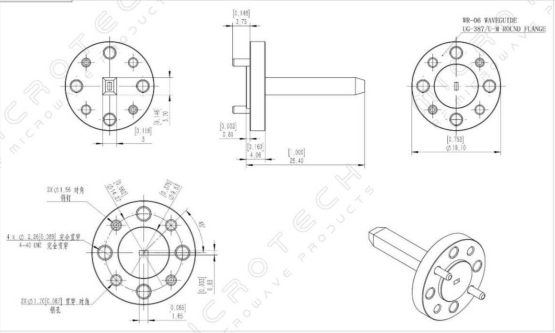A waveguide (or wave guide) is a hollow tubular transmission line made of a good conductor. It is a tool for propagating electromagnetic energy (mainly transmitting electromagnetic waves with wavelengths on the order of centimeters) Common tools (mainly transmitting electromagnetic waves with wavelengths on the order of centimeters).
The selection of rectangular waveguide size should consider the following factors:
1. Waveguide bandwidth problem
To ensure that electromagnetic waves within a given frequency range can propagate in a single TE10 mode in the waveguide, other high-order modes should be cut off, then b<a/2;
2. Waveguide power capacity problem
When propagating the required power, the waveguide cannot break down. Appropriately increasing b can increase the power capacity, so b should be as large as possible.

3. Attenuation of waveguide
After the microwave passes through the waveguide, it is hoped that the power will not be lost too much. Increasing b can make the attenuation smaller, so b should be as large as possible.
Considering the appealing factors, the size of the rectangular waveguide is generally selected as:
a=0.7λ, λ is the cut-off wavelength of TE10
b=(0.4-0.5)a
Most rectangular waveguides are designed with an aspect ratio of a:b=2:1, known as standard waveguides, so that a maximum bandwidth ratio of 2:1 can be achieved, that is, the ratio of the highest frequency to the lowest cutoff frequency is 2:1. In order to improve the power capacity, the waveguide with b>a/2 is called high waveguide; in order to reduce the volume and weight, the waveguide with b<a/2 is called flat waveguide.
The maximum bandwidth ratio that the circular waveguide can propagate is 1.3601:1, that is, the ratio of the highest single-mode frequency to the lowest cut-off frequency is 1.3601:1. The recommended operating frequency for a rectangular waveguide is a frequency 30% above the cutoff frequency and 5% below the second highest mode cutoff frequency. These recommended values prevent frequency dispersion at lower frequencies and multimode operation at higher frequencies.
E-mail:info@rf-miso.com
Phone:0086-028-82695327
Website:www.rf-miso.com
Post time: Jun-12-2023







